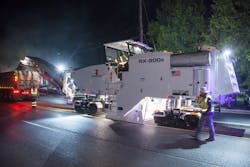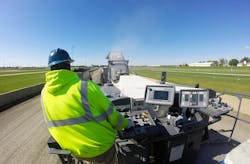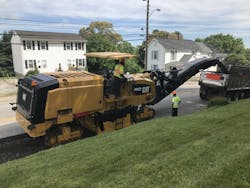Milling Machines Offer Fewer Players, but More Technology
The market for milling machines is on the upswing, not because of hope for a magical federal infrastructure package, but because of local efforts to shore up aging pavements. A relatively small amount of manufacturers (compared to other machine categories) is answering the call and continuing to refine technologies, such as grade control, for more precise production.
“The current mill market is up in comparison to 2017,” says Kyle Hammon, Roadtec’s product manager for Mills, Stabilizers, and Brooms. “Funding at the state level for pavement preservation and rehabilitation is contributing to the market increase.”
Caterpillar’s A.J. Lee, global sales consultant, is also bullish on the market. “We’re pleased with the growth in this important industry segment,” Lee says.
With Fayat’s Dynapac not currently marketing models in North America and Volvo’s exit from the business a few years ago, the remaining players are BOMAG (also part of the Fayat Group), Roadtec, Caterpillar, and Wirtgen (now part of John Deere).
Fewer choices may make things a touch easier when it comes to purchasing, but managers still have to do their homework.
Lee stresses a macro viewpoint. “Consider total cost of ownership,” he says. “This includes not just the purchase price, but also owning and operating costs, as well as resale value.”
Managers should keep an eye on features, weighing a feature-packed machine’s initial cost against the benefits particular technologies might provide.
“The most important thing is to choose a capable, flexible machine that will do its job without excessive maintenance costs,” says Jeff Wiley, SVP for Wirtgen America. “The purchaser should look for innovative technologies that save time and money by doing tasks that were not previously possible.”
One example Wiley cites is the two-diesel-engine configuration, called twin-engine drive, on the company’s W 210i and W 250i. “With two diesel engines, the machine operator can utilize engine power on demand when needed, reducing fuel costs by up to 25 percent compared to a comparable, conventional drive system,” Wiley says.
“Another example is Wirtgen’s Intelligent Speed Control (ISC) system,” he says. “Like a traction control system in a car, ISC minimizes spinning of the crawler tracks, enabling optimum traction in each one so the machine can achieve its optimum milling performance.”
Once the milling machine is added to the fleet, OEMs offer some operation-specific advice on how to keep costs down.
“One of the most effective—and overlooked—practices is to ensure that there are enough trucks available to prevent a stoppage due to waiting,” Lee says. “A waiting machine is not producing.”
Wiley agrees. “Effective truck management will boost the productivity of a milling operation. Operators need to be smart when it comes to managing trucks,” Wiley says. “Today’s machines have high productivity, and if you don’t have the right number of trucks for that machine to feed and keep it running steady, you will be inefficient. The milling operation should actually mill and load trucks at least 40 to 45 minutes out of the hour. If you are not doing that, you are not efficient.
“Therefore the operator needs to balance the trucks, pace himself a bit, and keep the machine running steady,” Wiley says. “That’s instead of running the machine wide open, then waiting 15 to 30 minutes for trucks to return.”
Superior Construction retrofit a milling machine with 3D laser control.
Wiley says it makes no difference if the trucks are owned by the milling company or provided by the prime contractor. “It’s a communications issue. The operator needs to meet and communicate with the prime contractor, giving him an idea of how productive his cold mill is, and based on that, weigh out the number of trucks that will be needed,” he says.
Also, consider a possible role for telematics in the owning and operating cost equation.
“Machine telematics can help managers quantify their operation costs from the job site or remotely,” Roadtec’s Hammon says. “When the telematics system allows the user to monitor the machine’s functions in real time, problems can be quickly diagnosed and costly downtime can be avoided.”
Another cost-lowering and accuracy-boosting idea that is seeing increased use in the field is the use of technologies for grade control. A quick look at manufacturers’ offerings reveals 2D and 3D help for operators.
Lee says Cat’s cold planers are 3D ready with the addition of aftermarket 3D components. “The milling quality can only be as good as the reference used. In conventional 2D milling, sensors—sonic or mechanical—are used to follow on-site grades and/or stringlines to provide a reference from which to determine how deep to mill,” he says.
Wirtgen’s Wiley believes a good ground person is essential to making the most out of systems.
“The ground man needs to make sure he’s got a reliable electronic grade-control system on the machine,” Wiley says. “It needs to be in good shape, and he has to understand how to operate it and adjust it to achieve his goals. He then needs to study the job site; some will require slope, while others will require averaging, or dual-grade. The ground man will need to know when and where and what time to adjust the machine to give the proper grade.”
Wirtgen’s system is called Level Pro. It includes a display panel, controller, and multiple sensors, along with software programmed specifically for milling machines. A variety of different sensors, such as milling depth, cross slope, or ultrasonic, can be integrated into the company’s automatic leveling system.
Wiley walked Construction Equipment through how the system works. “The graphics-enabled Level Pro panel provides a readout of key parameters. For example, the set and actual values of two active sensor signals and one passive sensor are continuously displayed on the screens as work progresses. An additional milling depth indicator on the screen—showing the difference between scraper blade and side plate positions—enables monitoring of the actual milling depth. In addition, the memory feature is extremely useful to preprogram, store, and retrieve set values,” Wiley says.
“This automatic system initiating the milling process enables the machine to mill at the maximum depth of 13 inches, in the case of our big mills, right from the start,” he continues. “When the automatic leveling system is activated, the machine is lowered automatically at maximum speed together with the rotating milling drum. Once the side plates reach the ground, the lifting columns continue lowering in slow mode; the lowering rate is adjusted further in the milled cut, if required. The machine retains its parallel alignment and no time is wasted on complex manual lowering processes.”
Roadtec uses the ACE grade and slope control on its milling machines. The system includes graphic displays, a sonic sensor, slope sensor, and sensors in the endgate cylinders. It provides the ability to automatically calibrate specific hydraulic parameters ensuring the machine consistently achieves the precise depth, according to Hammon. “For 3D or GPS milling, systems from Leica, Trimble, and Topcon can be integrated into Roadtec machines and communicate with the ACE system,” he says.
Whether using high-tech grade control or old-fashioned stringline, Hammon warns managers to watch their milling speed. “When milling machines travel too fast while cutting, the quality of the milled surface is adversely affected because the cutter drum could not properly remove all of the material. Also, more attention should be placed on the milled surface pattern, especially where thinner lifts of asphalt will be placed,” Hammon says.
Cat’s Lee advises changing bits more frequently to preserve the proper pattern and operating costs. “As [carbide] bits wear, they become shorter, which can affect the depth and pattern of the milling,” he says. “A dull bit also slows production and increases drag, which can add wear on the machine and result in higher owning and operating costs as repairs become necessary.
“Ensuring that the bits used are a match for the material and depth at which you are milling is important,” Lee says. “It can be counterproductive, for example, to try to squeeze two days of medium-duty production out of a bit that’s designed for light applications.”


